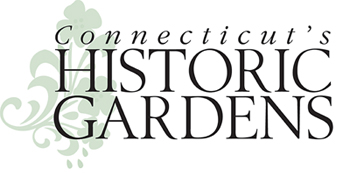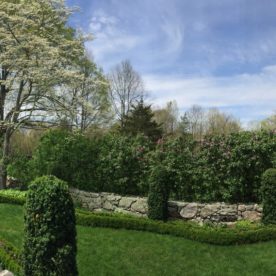Eileen Denver, a garden volunteer at the Glebe House Museum & Gertrude Jekyll Garden in Woodbury, CT gives us a bit of history about the site’s Gertrude Jekyll garden.
Nearly 100 years ago, the famous English garden designer Gertrude Jekyll was commissioned, sight unseen, to design perennial borders for the newly restored Glebe House, which had just opened to the public as a historic house museum. But the plan Jekyll sent to Woodbury in 1927 disappeared, no one knows why. Nearly 50 years later, a copy of her plan was discovered by a graduate student doing research at UC Berkeley’s School of Landscape Design. A copy of the plan had been among the papers bought upon Jekyll’s death by the well-known American garden designer Beatrix Farrand. When Farrand died, all the papers in her collection went to the landscape school archives.
The Glebe House Museum
welcomed back the plan. Soon, a large group of volunteers–including
horticulturalists, local gardeners, landscapers, and ag-school students–teamed
up to study the plan and, eventually, to install the borders. The first shovel
went in the ground in the late 1980’s, with photos and articles in a wide
variety of newspapers and magazines spotlighting the beauties of the hardy
perennial border whose drifts of color and cottage-gardening approach were
changing the face of American gardening.
In the first few years, the gardeners had to make some necessary changes, to
accommodate the New England winters and to substitute for plants that were not
available in the U.S. As the years went by, a smaller group of volunteer
gardeners now tended the garden on a twice-a-week basis. Other changes happened
over time — some of the perennials shouldered out others, or failed to
flourish after a while. The garden volunteers made changes as necessary,
keeping in mind what the original plan called for in terms of color, height,
and bloom time.
Now the team has decided the garden needs to be restored to be closer to Jekyll’s
original plan. To begin the restoration, one team member put in a huge number
of hours researching exactly what the original plan calls for and, if
substitutions are necessary, which would be closest to the Jekyll plan. The
team is faced with the complex project of making a multitude of changes in a
garden that is always on show. Plans have been drawn up and we have begun the
restoration, moving in some new perennials, digging out and selling some of the
older plants, transplanting some of the perennials we have to different spots,
creating a nearby growing-on garden as a holding pen for plants we will
eventually use. It will take several years, and funds are very limited. But
restoring the only Jekyll garden in the country is an exciting project, and it
should be a boon both for the Glebe House Museum, for Woodbury, and for
interested gardeners from all over.


